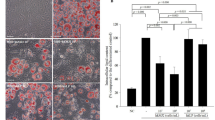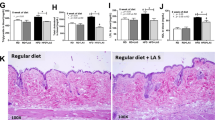Abstract
Background/Objectives:
The population of the obese is increasing worldwide. Prevention and improvement of obesity are indispensable for decreasing the risk of metabolic disorders. We have recently shown that obesity and fatty liver are reduced by a plant-derived lactic acid bacterium, Pediococcus pentosaceus LP28 (LP28), in high-fat diet-induced obese mice. The aim of the present clinical study is to prove that LP28 is effective for reducing body fat and body weight, as shown in the experiment using mice.
Subjects/Methods:
The clinical trial was carried out as a double-blind, randomized, placebo-controlled study comprising 62 subjects (20–70 years of age, BMI 25–30 kg/m2). These subjects were randomly assigned to three groups that received living LP28, heat-killed LP28 or a placebo powder, administered orally once a day for 12 weeks.
Results:
Heat-killed LP28 reduced BMI (0.45 kg/m2, 95% CI (0.04, 0.86), P=0.035), body fat percentage (1.11%, (0.39, 1.82), P=0.002), body fat mass (1.17 kg (0.43, 1.92), P=0.004) and waist circumference (2.84 cm (0.74, 4.93), P=0.009) when compared with a placebo group. Fasting plasma glucose, HbA1c, fasting insulin, HOMA-IR and serum lipids levels did not change by either living LP28 or heat-killed LP28 intake.
Conclusions:
Heat-killed LP28 displays an antiobesity effect that reduces BMI, body fat and waist circumference, suggesting that the plant-derived lactic acid bacterium LP28 would be a promising preventive of metabolic syndrome.
This is a preview of subscription content, access via your institution
Access options
Subscribe to this journal
Receive 12 print issues and online access
$259.00 per year
only $21.58 per issue
Buy this article
- Purchase on Springer Link
- Instant access to full article PDF
Prices may be subject to local taxes which are calculated during checkout

Similar content being viewed by others
References
Finucane MM, Stevens GA, Cowan MJ, Danaei G, Lin JK, Paciorek CJ et alfor the Global Burden of Metabolic Risk Factors of Chronic Diseases Collaborating Group (body mass index). National, regional, and global trends in body-mass index since 1980: systematic analysis of health examination surveys and epidemiological studies with 960 country-years and 9.1 million participants. Lancet 2011; 377: 557–567.
Kosaka K, Noda M, Kuzuya T . Prevention of type 2 diabetes by lifestyle intervention: a Japanese trial in IGT males. Diabetes Res Clin Pract 2005; 67: 152–162.
Lindström J, Peltonen M, Eriksson JG, Ilanne-Parikka P, Aunola S, Keinänen-Kiukaanniemi S et al. Finnish Diabetes Prevention Study (DPS). Improved lifestyle and decreased diabetes risk over 13 years: long-term follow-up of the randomised Finnish Diabetes Prevention Study (DPS). Diabetologia 2013; 56: 284–293.
Medina-Gomez G, Vidal-Puig A . Gateway to metabolic syndrome. Nat Med 2005; 11: 602–603.
Zhao X, Higashikawa F, Noda M, Kawamura Y, Matoba Y, Kumagai T et al. The obesity and fatty liver are reduced by plant-derived Pediococcus pentosaceus LP28 in high fat diet-induced obese mice. PLOS One 2012; 7: e30696.
Rolfe RD . The role of probiotic cultures in the control of gastrointestinal health. J Nutr 2000; 130: 396S–402S.
Adolfsson O, Meydani SN, Russell RM . Yoghurt and gut function. Am J Clin Nutr 2004; 80: 245–256.
Kumar M, Nagpal R, Kumar R, Hemalatha R, Verma V, Kumar A et al. Cholesterol-lowering probiotics as potential biotherapeutics for metabolic diseases. Exp Diabetes Res 2012; 2012: 902917.
de Moreno de LeBlanc A, Matar C, Perdigo'n G . The application of probiotics in cancer. Br J Nutr 2007; 98: S105–S110.
Lee HY, Park JH, Seok SH, Baek MW, Kim DJ, Lee KE et al. Human originated bacteria, Lactobacillus rhamnosus PL60, produce conjugated linoleic acid and show anti-obesity effects in diet-induced obese mice. Biochim Biophys Acta 2006; 1761: 736–744.
Ma X, Hua J, Li Z . Probiotics improve high fat diet-induced hepatic steatosis and insulin resistance by increasing hepatic NKT cells. J Hepatol 2008; 49: 821–830.
Wada T, Noda M, Kashiwabara F, Jeon HJ, Shirakawa A, Yabu H et al. Characterization of four plasmids harboured in a Lactobacillus brevis strain encoding a novel bacteriocin, brevicin 925 A, and construction of a shuttle vector for lactic acid bacteria and Escherichia coli. Microbiology 2009; 155: 1726–1737.
Jin H, Higashikawa F, Noda M, Zhao X, Matoba Y, Kumagai T et al. Establishment of an in vitro Peyer's patch cell culture system correlative to in vivo study using intestine and screening of lactic acid bacteria enhancing intestinal immunity. Biol Pharm Bull 2010; 33: 289–293.
Higashikawa F, Noda M, Awaya T, Nomura K, Oku H, Sugiyama M . Improvement of constipation and liver function by plant-derived lactic acid bacteria: a double-blind, randomized trial. Nutrition 2010; 26: 367–374.
Nomura M, Kobayashi M, Narita T, Kimoto-Nira H, Okamoto T . Phenotypic and molecular characterization of Lactococcus lactis from milk and plants. J Appl Microbiol 2006; 101: 396–405.
Seino Y, Nanjo K, Tajima N, Kadowaki T, Kashiwagi A, Araki E et al. Report of the committee on the classification and diagnostic criteria of diabetes mellitus. J Diabetes Invest 2010; 1: 212–228.
Matthews DR, Hosker JP, Rudenski AS, Naylor BA, Treacher DF, Turner RC . Homeostasis model assessment: insulin resistance and beta-cell function from fasting plasma glucose and insulin concentrations in man. Diabetologia 1985; 28: 412–419.
IBM SPSS Statistics. Available from: http://www-01.ibm.com/software/analytics/spss/products/statistics/ accessed on 27 February 2016.
Li P, Stuart EA, Allison DB . Multiple imputation: a flexible tool for handling missing data. JAMA 2015; 314: 1966–1967.
Wang YC, McPherson K, Marsh T, Gortmarker SL, Brown M . Health and economic burden of the projected obesity trends in the USA and the UK. Lancet 2011; 378: 818–825.
Lee JW, Brancati FL, Yeh HC . Trends in the prevalence of type 2 diabetes in Asians versus whites: results from the United States National Health Interview Survey, 1997–2008. Diabetes Care 2011; 34: 353–357.
Yusuf S, Hawken S, Ounpuu S, Bautista L, Franzosi MG, Commerford P et al. Obesity and the risk of myocardial infarction in 27,000 participants from 52 countries: a case-control study. Lancet 2005; 366: 1640–1649.
Savva SC, Lamnisos D, Kafatos AG . Predicting cardiometabolic risk: waist-to-height ratio or BMI. A meta-analysis. Diabetes Metab Syndr Obes 2013; 6: 403–419.
Reagan-Shaw S, Nihal M, Ahmad N . Dose translation from animal to human studies revisited. FASEB J 2008; 22: 659–661.
Cao H . Adipocytokines in obesity and metabolic disease. J Endocrinol 2014; 220: T47–T59.
Lee S, Kwak HB . Role of adiponectin in metabolic and cardiovascular disease. J Exerc Rehabil 2014; 10: 54–59.
Acknowledgements
This study was financially supported by Grants-in-Aid for Scientific Research (Kiban C 23617013 to FH) from the Ministry of Education, Culture, Sports, Science and Technology, Japan. We thank Dr Yongxin Shen at the Clinical Research Center for undertaking the random allocation of study subjects. FH and MS designed the research and had primary responsibility for the final content. FH, MN, TA and ND conducted the research. FH was in charge of statistical analysis and prepared the manuscript. YM and TK supported the statistical analysis of the results from the clinical study. All authors read and approved the final manuscript.
Author information
Authors and Affiliations
Corresponding author
Ethics declarations
Competing interests
Hiroshima University has a patent on the use of LP28 as an antiobesity reagent, and FH, MN and MS are co-inventors on that patent. TA, ND, YM and TK declare no conflicts of interest.
Rights and permissions
About this article
Cite this article
Higashikawa, F., Noda, M., Awaya, T. et al. Antiobesity effect of Pediococcus pentosaceus LP28 on overweight subjects: a randomized, double-blind, placebo-controlled clinical trial. Eur J Clin Nutr 70, 582–587 (2016). https://doi.org/10.1038/ejcn.2016.17
Received:
Revised:
Accepted:
Published:
Issue Date:
DOI: https://doi.org/10.1038/ejcn.2016.17
This article is cited by
-
Role of folic acid in regulating gut microbiota and short-chain fatty acids based on an in vitro fermentation model
Applied Microbiology and Biotechnology (2024)
-
Pediococcus pentosaceus MIANGUAN Enhances the Immune Response to Vaccination in Mice
Probiotics and Antimicrobial Proteins (2024)
-
Role of Phenolic Acid Metabolism in Enhancing Bioactivity of Mentha Extract Fermented with Plant-Derived Lactobacillus plantarum SN13T
Probiotics and Antimicrobial Proteins (2023)
-
Antioxidant potential of Pediococcus pentosaceus strains from the sow milk bacterial collection in weaned piglets
Microbiome (2022)
-
Probiotics’ effect on visceral and subcutaneous adipose tissue: a systematic review of randomized controlled trials
European Journal of Clinical Nutrition (2022)



